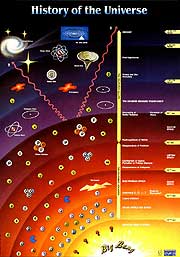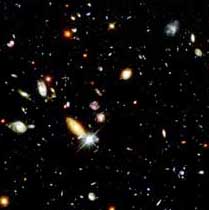|

photo: CERN
Click photo to view expanded History of the Universe.
|

Did
you know that the matter in your body is billions of years
old?
According to most astrophysicists, all the matter found
in the universe today -- including the matter in people,
plants, animals, the earth, stars, and galaxies -- was created
at the very first moment of time, thought to be about 13
billion years ago.
The universe began, scientists believe, with every speck
of its energy jammed into a very tiny point. This extremely
dense point exploded with unimaginable force, creating matter
and propelling it outward to make the billions of galaxies
of our vast universe. Astrophysicists dubbed this titanic
explosion the Big Bang.
The Big Bang was like no explosion you might witness on
earth today. For instance, a hydrogen bomb explosion, whose
center registers approximately 100 million degrees Celsius,
moves through the air at about 300 meters per second. In
contrast, cosmologists believe the Big Bang flung energy
in all directions at the speed of light (300,000,000 meters
per second, a million times faster than the H-bomb)
and estimate that the temperature of the entire universe
was 1000 trillion degrees Celsius at just a tiny fraction
of a second after the explosion. Even the cores of the hottest
stars in today's universe are much cooler than that.
There's another important quality of the Big Bang that makes
it unique. While an explosion of a man-made bomb expands
through air, the Big Bang did not expand through anything.
That's because there was no space to expand through at the
beginning of time. Rather, physicists believe the Big Bang
created and stretched space itself, expanding the universe.
A
Cooling, Expanding Universe
|

photo: Space Telescope
Science Institute
As the early universe cooled, the matter produced
in the Big Bang gathered into stars and galaxies.
|
For
a brief moment after the Big Bang, the immense heat created
conditions unlike any conditions astrophysicists see in
the universe today. While planets and stars today are composed
of atoms of elements like hydrogen and silicon, scientists
believe the universe back then was too hot for anything
other than the most fundamental particles -- such as quarks
and photons.
But as the universe quickly expanded, the energy of the
Big Bang became more and more "diluted" in space, causing
the universe to cool. Popping open a beer bottle results
in a roughly similar cooling, expanding effect: gas, once
confined in the bottle, spreads into the air, and the temperature
of the beer drops.
Rapid cooling allowed for matter as we know it to form in
the universe, although physicists are still trying to figure
out exactly how this happened. About one ten-thousandth
of a second after the Big Bang, protons and neutrons formed,
and within a few minutes these particles stuck together
to form atomic nuclei, mostly hydrogen and helium. Hundreds
of thousands of years later, electrons stuck to the nuclei
to make complete atoms.
About a billion years after the Big Bang, gravity caused
these atoms to gather in huge clouds of gas, forming collections
of stars known as galaxies. Gravity is the force that pulls
any objects with mass towards one another -- the same force,
for example, that causes a ball thrown in the air to fall
to the earth.
Where do planets like earth come from? Over billions of
years, stars "cook" hydrogen and helium atoms in their hot
cores to make heavier elements like carbon and oxygen. Large
stars explode over time, blasting these elements into space.
This matter then condenses into the stars, planets, and
satellites that make up solar systems like our own.
How
do we know the Big Bang happened?
Astrophysicists have uncovered a great deal of compelling
evidence over the past hundred years to support the Big
Bang theory. Among this evidence is the observation that
the universe is expanding. By looking at light emitted by
distant galaxies, scientists have found that these galaxies
are rapidly moving away from our galaxy, the Milky Way.
An explosion like the Big Bang, which sent matter flying
outward from a point, explains this observation.

Did you know that the static on your television is caused
by radiation left over from the Big Bang?
|
Another
critical discovery was the observation of low levels of
microwaves throughout space. Astronomers believe these microwaves,
whose temperature is about -270 degrees Celsius, are the
remnants of the extremely high-temperature radiation produced
by the Big Bang.
Interestingly, astronomers can get an idea of how hot the
universe used to be by looking at very distant clouds of
gas through high-power telescopes. Because light from these
clouds can take billions of years to reach our telescopes,
we see such bodies as they appeared eons ago. Lo and behold,
these ancient clouds of gas seem to be hotter than younger
clouds.
Scientists have also been able to uphold the Big Bang theory
by measuring the relative amounts of different elements
in the universe. They've found that the universe contains
about 74 percent hydrogen and 26 percent helium by mass,
the two lightest elements. All the other heavier elements
-- including elements common on earth, such as carbon and
oxygen -- make up just a tiny trace of all matter.
So how does this prove anything about the Big Bang? Scientists
have shown, using theoretical calculations, that these abundances
could only have been made in a universe that began in a
very hot, dense state, and then quickly cooled and expanded.
This is exactly the kind of universe that the Big Bang theory
predicts.
next
page...
|